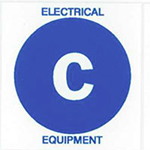On this page
Extinguishers

Class A
Class A extinguishers will put out fires in ordinary combustibles, such as wood and paper. The numerical rating for this class of fire extinguisher refers to the amount of water the fire extinguisher holds and the amount of fire it will extinguish.

Class B
Class B Extinguishers should be used on fires involving flammable liquids, such as grease, gasoline, oil, etc. The numerical rating for this class of fire extinguisher states the approximate number of square feet of a flammable liquid fire that a non-expert person can expect to extinguish.

Class C
Class C extinguishers are suitable for use on electrically energized fires. This class of fire extinguishers does not have a numerical rating. The presence of the letter “C” indicates that the extinguishing agent is non-conductive.

Class D
Class D Extinguishers are designed for use on flammable metals and are often specific for the type of metal in question. There is no picture designator for Class D extinguishers. These extinguishers generally have no rating nor are they given a multi-purpose rating for use on other types of fires.
PASS – Pull, Aim, Squeeze and Sweep
Pull the pin at the top of the extinguisher. The pin releases a locking mechanism and will allow you to discharge the extinguisher.
Aim at the base of the fire, not the flames. This is important – in order to put out the fire, you must extinguish the fuel.
Squeeze the lever slowly. This will release the extinguishing agent in the extinguisher. If the handle is released, the discharge will stop.
Sweep from side to side. Using a sweeping motion, move the fire extinguisher back and forth until the fire is completely out. Operate the extinguisher from a safe distance, several feet away, and then move towards the fire once it starts to diminish. Be sure to read the instructions on your fire extinguisher – different fire extinguishers recommend operating them from different distances. Remember: Aim at the base of the fire, not at the flames!
Remember, when attempting to fight a small confined fire, make sure you do not get trapped with it in the room. Always make sure you have a clear path to an exit!
- Extinguishers are only first aid equipment
- Don’t fight a fire unless you have called 911
- The fire is small
- You have the proper extinguisher
- You know how to use the extinguisher
Extinguishers must be checked on a monthly and yearly basis. It is a requirement under the Fire Code that all businesses and Industries along with multi-residential buildings have the required type and number of extinguishers in the proper locations.
For more information
Guelph Fire Prevention Division
519-763-8111
